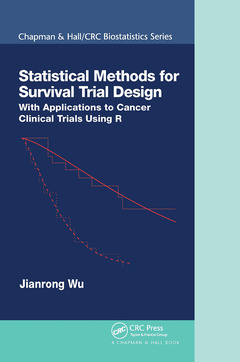Description
Statistical Methods for Survival Trial Design
With Applications to Cancer Clinical Trials Using R
Chapman & Hall/CRC Biostatistics Series
Author: Wu Jianrong
Language: English
Subjects for Statistical Methods for Survival Trial Design:
Keywords
Log Rank Tests; Sample Size Calculation; Sample size; Martingale Central Limit Theorem; time-to-event; Survival Trial Design; survival distribution; Weighted Log Rank Test; proportional hazards model; Sample Size Formula; non-proportional hazards model; Interim Analysis; delay treatment effect model; Standard Log Rank Test; Nonparametric Log Rank Test; Uniform Accrual; Group Sequential Procedure; Accrual Period; Cox Regression Model; Parametric Survival Distribution; Nonproportional Hazards Model; Fixed Sample Test; Weibull Model; Maximum Conditional Probability; Independent Increment Structure; Log Rank Score; Median Survival Time; Mixture Cure Model; Kaplan Meier Curves; Group Sequential
Publication date: 12-2020
· 15.6x23.4 cm · Paperback
Publication date: 06-2018
· 15.6x23.4 cm · Hardback
Description
/li>Contents
/li>Biography
/li>
Statistical Methods for Survival Trial Design: With Applications to Cancer Clinical Trials Using R provides a thorough presentation of the principles of designing and monitoring cancer clinical trials in which time-to-event is the primary endpoint.Traditional cancer trial designs with time-to-event endpoints are often limited to the exponential model or proportional hazards model. In practice, however, those model assumptions may not be satisfied for long-term survival trials.
This book is the first to cover comprehensively the many newly developed methodologies for survival trial design, including trial design under the Weibull survival models; extensions of the sample size calculations under the proportional hazard models; and trial design under mixture cure models, complex survival models, Cox regression models, and competing-risk models. A general sequential procedure based on the sequential conditional probability ratio test is also implemented for survival trial monitoring. All methodologies are presented with sufficient detail for interested researchers or graduate students.
Preface
List of Figures
List of Tables
1. Introduction to Cancer Clinical Trials
General Aspects of Cancer Clinical Trial Design
Study Objectives
Treatment Plan
Eligibility Criteria
Statistical Considerations
Statistical Aspects of Cancer Survival Trial Design
Randomization
Stratification
Blinding
Sample Size Calculation
2. Survival Analysis
Survival Distribution
Exponential Distribution
Weibull Distribution
Gamma Distribution
Gompertz Distribution
Log-Normal Distribution
Log-Logistic Distribution
Survival Data
Fitting the Parametric Survival Distribution
Kaplan-Meier Estimates
Median Survival Time
Log-Rank Test
Cox Regression Model
3. Counting Process and Martingale_
Basic Convergence Concepts
Counting Process Definition
Martingale Central Limit Theorem
Counting Process Formulation of Censored Survival Data
4. Survival Trial Design Under the Parametric Model
Introduction
Weibull Model
Test Statistic
Distribution of the MLE test
Sample Size Formula
Sample Size Calculation
Accrual Duration Calculation
Example and R code
5. Survival Trial Design Under the Proportional Hazards Model
Introduction
Proportional Hazards Model
Asymptotic Distribution of the Log-rank Test
Schoenfeld Formula
Rubinstein Formula
Freedman Formula
Comparison
Sample Size Calculation Under Various Models
Example
Optimal Properties of the Log-Rank Test_
Optimal Sample Size Allocation
Optimal Power
Precise Formula
Exact Formula
6. Survival Trial Design Under the Cox Regression Model
Introduction
Test Statistics
Asymptotic Distribution of the Score Test_
Sample Size Formula
7. Complex Survival Trial Design
Extension of the Freedman Formula
Example and R code
Lakatos Formula
Markov Chain Model with Simultaneous Entry
Computation Formulae
Markov Chain Model with Staggered Entry
Examples and R code
8. Survival Trial Design Under the Mixture Cure Model
Introduction
Testing Differences in Cure Rates
Mixture Cure Model
Asymptotic Distribution
Sample Size Formula
Optimal Log-Rank Test
Comparison
Example and R code
Conclusion
Testing Differences in Short- and Long-Term Survival
Hypothesis Testing
Ewell and Ibrahim Formula
Simulation
Example and R code
Conclusion
9. A General Group Sequential Procedure
Brownian Motion
Sequential Conditional Probability Ratio Test
Operating Characteristics
Probability of Discordance
SCPRT Design
10. Sequential Survival Trial Design
Introduction
Sequential Procedure for the Parametric Model
Sequential Wald Test
SCPRT for the Parametric Model
Sequential Procedure for the Proportional Hazard Model
Sequential Log-Rank Test
Information Time
SCPRT for the PH Model
11. Sequential Survival Trial Design Using Historical Controls
Introduction
Sequential Log-Rank Test with Historical Controls
Sample Size Calculation
Information Time
Group Sequential Procedure
Conclusion
12. Some Practical Issues in Survival Trial Design
Parametric vs Nonparametric Model
Nonproportional Hazards Model
Accrual Patterns
Mixed Populations
Loss to Follow-Up
Noncompliance and Drop-In
Competing Risk
A Likelihood Function For the Censored Data
B Probability of Failure Under Uniform Accrual
C Verification of the Minimum Sample Size Conditions
D R Codes for the Sample Size Calculations
E Derivation of the Asymptotic Distribution
F Derivation of Equations for Chapter
Bibliography
Index
Jianrong (John) Wu is a professor in the Division of Cancer Biostatistics, Department of Biostatistics, Markey Cancer Center, University of Kentucky. He has more than 15 years’ experience of designing and conducting cancer clinical trials at St. Jude Children’s Research Hospital and has developed several novel statistical methods for designing phase II and phase III survival trials.




